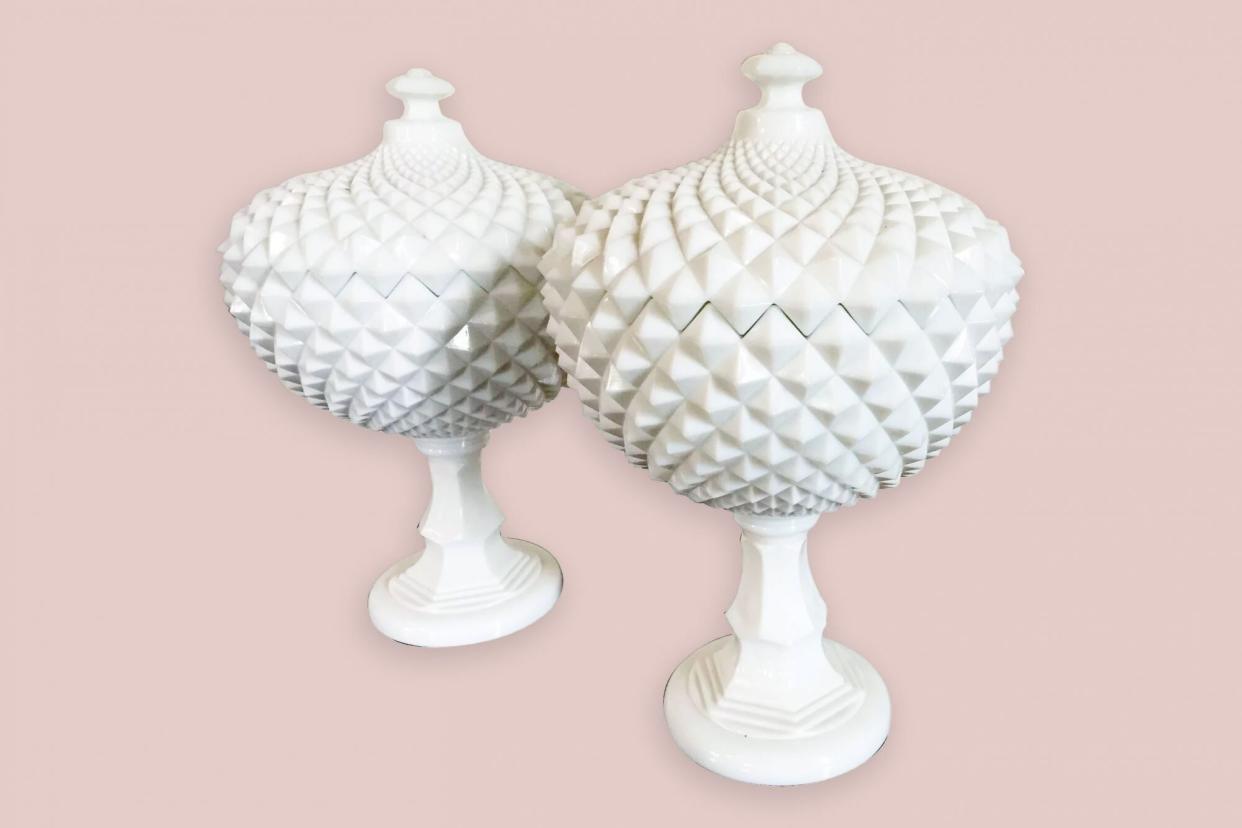How Much Is Milk Glass Really Worth?

Courtesy of Ruby Lane
We're willing to guess that you're at least vaguely acquainted with milk glass, since specimens are stashed in the antiques shops all across America. But your grandmother likely remembers it well-it sat on her bedside table, she might have had a milk glass reading lamp, or a tremendous white punch bowl that seemed to glow like an opal may have been in her kitchen. And maybe her grandmother fastened collar to blouse each morning with a couple of steel pins, each one tipped with a lustrous milk glass teardrop-pins she kept scattered on a milk glass dresser tray.
Related: All About Carnival Glass-What Is It and How Do You Collect It?
The History of Milk Glass
Creating opaque white glass is an ancient art, since similar vessels were made as early as 1500 B.C. in Egypt. But the term "milk glass" almost always refers to the white glass that was popular from 1835 through the 1980s in America and England. It arrived on waves of technical innovation: The most significant contribution of the United States to glass production occurred in the 1820s, when machinery to press molten glass into metal molds was invented and perfected. In the early factories, molten glass was dropped into heavy iron molds. A worker then lowered a plunger to force the molten glass into every interstice and corner of the mold. To create milk glass, early manufacturers added arsenic to their standard glass recipes, which yielded a faintly grayish but nicely opalescent effect. Later, they used tinoxide, feldspar, and other additives to achieve a more saturated ivory hue.
Milk glass originally appeased an expanding middle class who aspired to the finer things in life. It was porcelain for the masses, an inexpensive substitute for luxurious tableware and accessories made by such companies as Wedgwood and Spode, whose designs it sometimes imitated shamelessly. Milk glass assumed many forms. The 1870s saw the rise of bowls and compotes. In the 1890s, fanciful dresser sets were the rage; one manufacturer, Fostoria Glass Company, created a set embossed with portraits of the actress Jenny Lind. Around the turn of the century, novelty pieces became popular: blown-glass Easter eggs and tiny milk-glass suitcases bearing the legend "Souvenir of Niagara Falls."
Determining the Value
Because milk glass has been in constant production since the 1860s, collectors have a plethora of articles to choose from-and a great deal to learn. An old, rare piece of milk glass can fetch several thousand dollars, while a charming butter dish from the 1950s that looks like your old dotted Swiss pinafore can be brought home for $10. It's important, and not always easy, to be able to tell the difference.
New collectors can visit antiques shops or glass shows to get a "feel" for as many types of pieces as possible. Few American manufacturers marked their glass. To top it off, glasshouses habitually caught on fire and shut down, and the molds were auctioned, scattered, and reused by other companies, making it maddeningly difficult to tell when, where, or by whom a piece was made. One of the largest producers in the 20th century was Westmoreland Glass Company of Grapeville, Pennsylvania; its factory closed in 1985. Only a handful of companies still manufacture milk glass, including the well-known Fenton Art Glass Company of Williamstown, West Virginia.
Some older milk glass contains quantities of lead and will ring like a bell when tapped. "If you hold it up to the light, there are sometimes wonderful fiery colors around the edges, as if the glass were illuminated from the inside," says Frank Chiarenza, a collector and co-author of The Milk Glass Book ($49.95, amazon.com). But newer milk glass also has its selling points: It's plentiful, undervalued, and so sturdy that you can put it in the dishwasher.
So don't hesitate to buy milk glass dinnerware to use every day, suggests Chiarenza. You might begin by collecting milk glass vases, massing their luminous white forms. "I could also see filling a bathroom window with shelves of milk glass," says Chiarenza, "because light is what makes it magical."
